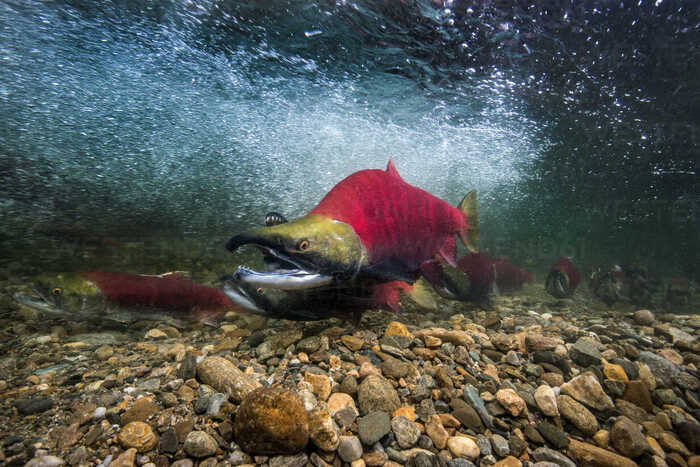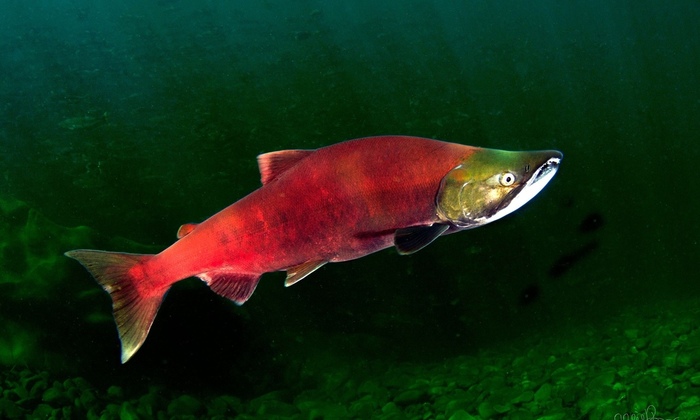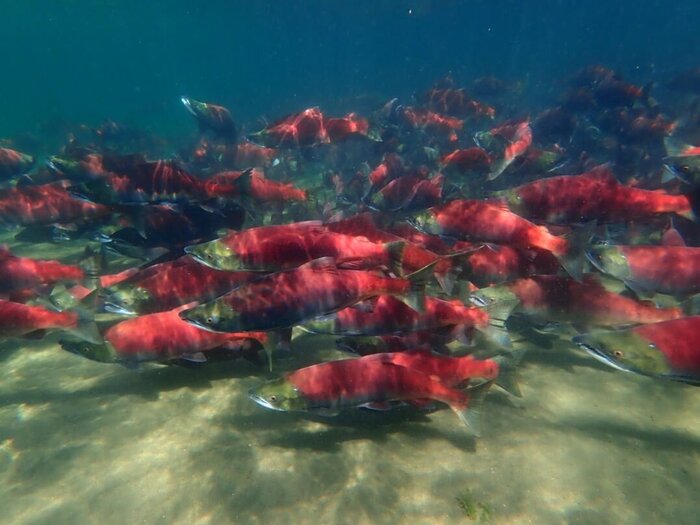Sockeye salmon (Oncorhynchus nerka) also called red salmon, kokanee salmon, blueback salmon, or simply sockeye,is one of the most iconic and ecologically significant species in the Pacific salmon family. Recognizable for its vibrant red color during spawning, sockeye salmon plays a pivotal role in both marine and freshwater ecosystems. This detailed guide will explore the various aspects of sockeye salmon, from its classification and physical characteristics to its unique migratory patterns, reproductive strategies, and conservation status.

Sockeye salmon (Oncorhynchus nerka) is classified within the Salmonidae family, which includes various species of salmon, trout, and chars. The scientific taxonomy of sockeye salmon is as follows:
Kingdom: Animalia
Phylum: Chordata
Class: Actinopterygii (Ray-finned fish)
Order: Salmoniformes
Family: Salmonidae
Genus: Oncorhynchus
Species: Oncorhynchus nerka
Sockeye salmon belongs to the Oncorhynchus genus, which is a group of Pacific salmon species. Other members of this genus include Chinook salmon (Oncorhynchus tshawytscha), Coho salmon (Oncorhynchus kisutch), and Pink salmon (Oncorhynchus gorbuscha). Sockeye is particularly known for its migratory life cycle, where it spends most of its life in the ocean and then returns to freshwater to spawn.
Sockeye salmon are famous for their striking physical appearance, particularly during the spawning season. While in the ocean, they have a sleek, silvery body that helps them blend with the environment, making it harder for predators to spot them. However, during the spawning season, both males and females undergo a remarkable physical transformation. Males develop a hooked jaw (kype), and both sexes acquire a vivid red or orange coloration, particularly on their backs. This change is primarily driven by hormonal shifts related to reproduction.
Sockeye salmon typically reach an average length of 24 to 30 inches (60 to 76 cm) and can weigh between 5 to 15 pounds (2 to 7 kg). However, some exceptional individuals can grow even larger under favorable conditions. Their streamlined bodies and powerful tails allow them to swim long distances during migration, supporting their anadromous lifecycle.
Sockeye salmon generally have a lifespan ranging from 3 to 5 years, though some individuals may live up to 6 years. After spending the majority of their life in the ocean, they return to freshwater rivers to spawn. The exhaustion from migration and the physiological toll of spawning generally leads to their death after reproduction.
Sockeye salmon have a global distribution in the northern Pacific region, particularly along the coasts of Alaska, British Columbia, and parts of Russia. These fish spend the majority of their life in the open ocean, where they grow and mature, before returning to freshwater rivers for spawning. These rivers need to have clean, cold water for successful reproduction. Key river systems where sockeye salmon are found include the Fraser River (Canada), the Columbia River (USA), and the Yukon River (Alaska).
Sockeye salmon also thrive in areas where the temperature of freshwater is low, typically ranging from 5°C to 12°C (41°F to 54°F), which is conducive to the survival of the species during their early life stages. During their time in the ocean, they prefer colder, deeper waters that support a rich diversity of plankton and smaller fish, their main food sources.
Sockeye salmon play an indispensable role in the ecosystems they inhabit. Their lifecycle links the ocean and freshwater environments, providing nutrients from marine environments to terrestrial and freshwater ecosystems. Upon their return to freshwater rivers to spawn, their decomposing bodies provide essential nutrients to the riverbeds, fertilizing the soil and helping sustain various plants and animal species.
Sockeye salmon are solitary during most of their life, but their behavior changes dramatically during spawning. Males establish dominance over specific spawning sites, while females seek the best locations to lay their eggs (redds). Males and females engage in a competition for these territories, with aggressive displays and physical confrontations. These interactions are crucial for ensuring the strongest genes are passed on to the next generation.
In addition to competitive behavior during spawning, sockeye salmon exhibit fascinating migration behavior. They navigate vast distances between the ocean and their natal rivers using environmental cues, such as water chemistry, to find their exact spawning location.

Sockeye salmon are known for their extensive and remarkable migratory patterns. Every year, millions of sockeye salmon leave their ocean habitats to return to the freshwater rivers where they were born. This migration can span over 1,000 miles (1,600 km) or more, depending on the location of their natal rivers.
The migration begins in the spring and summer, with the adult fish traveling upstream to reach the spawning grounds. They use a combination of visual landmarks, the Earth's magnetic field, and chemical cues in the water to guide them on their journey. This homing instinct is so precise that sockeye salmon can return to the exact river and even the same tributary in which they were born, a phenomenon known as natal homing.
Throughout their lifecycle, sockeye salmon engage in different activities based on their stage of development. When in the ocean, sockeye salmon focus on foraging and growing, consuming a diet rich in small fish, zooplankton, and crustaceans. Their feeding behavior is opportunistic, adapting to the availability of food sources, which supports their rapid growth and energy needs during migration.
During spawning, their behavior shifts dramatically. Male sockeye salmon establish territories and defend them aggressively to attract females. These territorial displays include changing body colors, engaging in physical confrontations, and using their large jaws to compete. Once the eggs are laid, the adult salmon typically die, completing their lifecycle.
As opportunistic feeders, sockeye salmon have a varied diet depending on their life stage and habitat. While in the ocean, they primarily feed on zooplankton, small fish, and other marine organisms. In particular, their diet consists of krill, shrimp, and other planktonic creatures, which provide the necessary nutrients for their long migration and growth.
Sockeye salmon have been shown to exhibit specific foraging behaviors, with juveniles feeding in groups to minimize the risk of predation, while adults often forage solitarily. Their diet varies based on availability, and they are known to migrate toward areas with high concentrations of food.
Sockeye salmon follow an anadromous reproductive strategy, meaning they are born in freshwater, migrate to the ocean to grow, and return to their natal rivers to spawn. This remarkable process begins when adult sockeye salmon make their way upstream to their spawning grounds. Upon arrival, males fight for prime spawning locations, while females select areas to build nests, known as redds.
The spawning season for sockeye salmon is one of the most significant phases of their life cycle, involving a dramatic migration from the ocean to freshwater rivers. Here’s an overview of their spawning behavior and timing:
Time of Year: Sockeye salmon usually begin their spawning migration in the late summer to early fall, typically between July and November depending on the location.
Migration to Spawning Grounds: During this time, mature sockeye salmon begin their long migration from the ocean, where they have spent the majority of their lives, back to the freshwater rivers or lakes where they were born. This migration can cover distances of several hundred miles, depending on the river system.
Spawning Behavior: Upon reaching their spawning grounds, the sockeye salmon undergo significant physiological changes. The males develop a hooked jaw (kype), and both males and females acquire their characteristic red or orange coloration. The females lay their eggs in gravel nests, called redds, which they create by digging into the riverbed using their tails. Males fertilize the eggs after they are laid.
Death After Spawning: After spawning, most sockeye salmon die, completing their life cycle. Their bodies provide nutrients that support the ecosystems in which they live, offering an essential source of food for other animals, including birds, bears, and even smaller fish.
Environmental Conditions for Spawning: Sockeye salmon typically require cold, clean, and well-oxygenated water for successful spawning. The temperature of the freshwater should range from 5°C to 12°C (41°F to 54°F). The presence of gravel beds in clear, fast-flowing streams is also crucial for creating a suitable environment for egg development.
Once the female lays her eggs in the gravel of the riverbed, the male fertilizes them. After spawning, both males and females typically die, their bodies providing nutrients that help fertilize the river ecosystem. The eggs hatch into alevins, which develop into fry and eventually juvenile salmon before making their way into the ocean.

Sockeye salmon populations face significant challenges due to human-induced factors such as overfishing, habitat destruction, and climate change. As a result, many sockeye salmon populations are classified as "threatened" or "endangered." In particular, dams and other barriers that block migratory routes prevent these fish from reaching their spawning grounds, a significant challenge for their survival.
Efforts to conserve sockeye salmon include restoring habitat, improving fish passage through dams, and reducing the impact of commercial fishing. Environmental agencies and conservation groups are actively working to protect these fish by restoring river habitats, managing water quality, and introducing regulations on fishing quotas.
Sockeye salmon face numerous threats throughout their life stages. In the ocean, they are preyed upon by larger fish such as seals, sea lions, and sharks. During their migration and spawning, they are also vulnerable to predation by birds, bears, and other wildlife.
Human activities, such as deforestation, pollution, and the construction of dams, exacerbate the challenges sockeye salmon face. These activities disrupt their habitats and make it more difficult for them to successfully complete their life cycle. Overfishing, especially in their spawning rivers, has further compounded the problem.
Sockeye salmon are integral to both aquatic and terrestrial ecosystems. In freshwater habitats, their decaying bodies contribute valuable nutrients to the surrounding environment, supporting plant life and sustaining a variety of organisms. Additionally, sockeye salmon play an essential role in the food chain, acting as prey for larger predators, including bears, birds, and marine mammals.
Their migration also has profound ecological implications, as sockeye salmon help transport nutrients between the ocean and freshwater ecosystems, contributing to the health of both environments.
Sockeye salmon has significant cultural and economic value, especially in Indigenous communities along the Pacific coasts of North America. For centuries, these fish have been a central food source, playing a vital role in the diets, economies, and traditions of Native American and Canadian First Nations peoples.
In addition to their cultural significance, sockeye salmon are economically important. Commercial and recreational fishing industries rely heavily on healthy salmon populations for food production and tourism. The fishing industry, particularly in regions like Alaska, contributes billions of dollars annually to the economy.
Sockeye salmon are not only an iconic species but also a vital part of the ecosystems they inhabit. Their remarkable migratory behavior, nutritional value in the food chain, and importance in nutrient cycling make them indispensable for maintaining ecological balance. However, with many populations facing severe threats, conservation efforts are crucial to preserving this extraordinary species. Through sustainable management and habitat restoration, we can ensure that sockeye salmon continue to thrive for generations to come.
By understanding the biology, behavior, and challenges of sockeye salmon, we gain a deeper appreciation for the interconnections between species and the natural world, emphasizing the importance of preserving our planet's biodiversity.
animal tags: Salmonidae
We created this article in conjunction with AI technology, then made sure it was fact-checked and edited by a Animals Top editor.